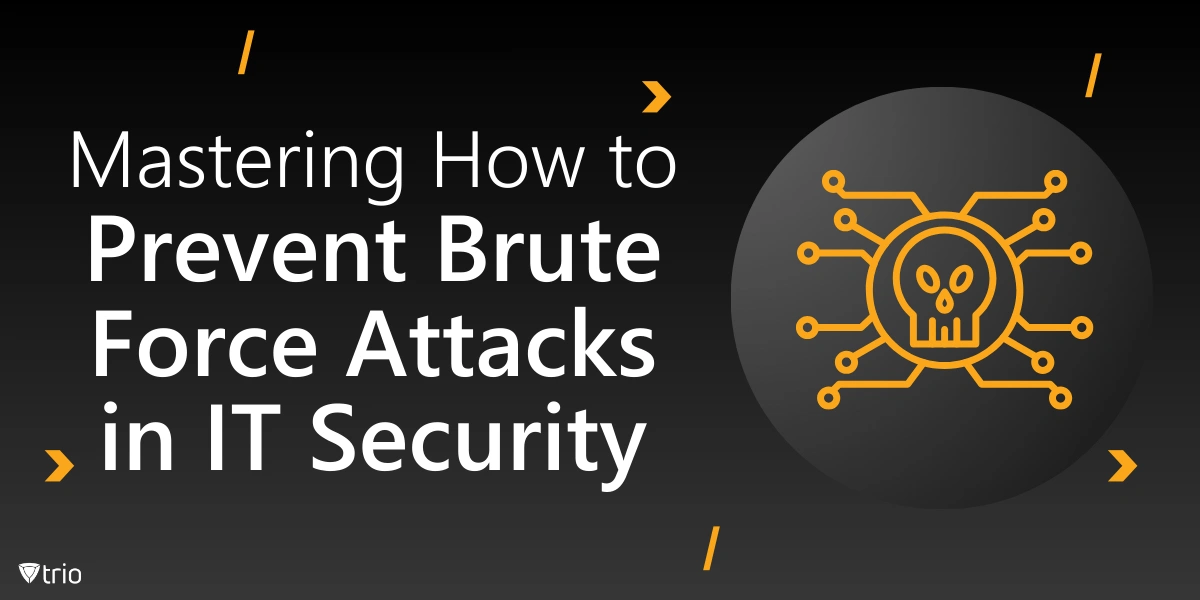Brute force attacks remain one of the most common methods cybercriminals use to gain unauthorized access to systems, user accounts, and sensitive data. This blog post will go over various types of brute force attacks, provide actionable steps for brute force prevention, and highlight how an MDM solution like Trio can add a crucial layer of protection. Knowing how to prevent brute force attacks is essential for any IT team aiming to keep their network secure and prevent data breaches.
What Brute Force Attack Means and Its Impact on Security
At its core, a brute force attack means the use of trial-and-error methods to crack passwords, encryption keys, or other sensitive information. Cybercriminals deploy brute force attempts by repeatedly guessing combinations, often using powerful software to increase the speed of their guesses. The main goal of a brute force attack is to gain unauthorized access to user accounts, web applications, or corporate databases.
Brute force attacks not only disrupt network security but also compromise valuable information, leading to company data breaches, reputation loss, and financial damages. The most alarming part? Even simple brute force attacks can succeed if accounts are only protected by weak or common passwords, exposing them to significant risks. This reality should make brute force attack protection a top priority for businesses and IT departments aiming to safeguard their systems.
Types of Brute Force Attacks
Understanding the different types of brute force attacks is essential for developing a robust defense strategy. Brute force attempts can take various forms, let’s look at some common examples of brute force attacks that every IT professional should recognize:
- Simple Brute Force Attacks: These are the most straightforward, relying on raw computing power to guess passwords, commonly used to target accounts with weak or simple passwords. Though often unsuccessful on complex accounts, they can easily breach user accounts with common passwords.
- Dictionary Attacks: Unlike simple brute force attacks, dictionary attacks rely on a predefined list of potential passwords, often drawn from common passwords that users may choose. By automating the process of checking each word in this “dictionary,” hackers can quickly crack passwords that fall within these predictable patterns.
- Reverse Brute Force Attacks: In reverse brute force attacks, attackers start with a known password and work to find a matching username. This approach is particularly useful when they already possess password information, like from a previous data breach.
- Hybrid Brute Force Attacks: A combination of a dictionary attack and a simple brute force attack, hybrid brute force attacks often start with a known or partially known password and use additional characters or guesses to increase the probability of success.
- Rainbow Table Attacks: Although not strictly a brute force attack, rainbow tables are precomputed tables of disrupted passwords that allow attackers to reverse-engineer encrypted passwords quickly. Password cracking tools like “John the Ripper” make these techniques accessible.
Each attack type has its nuances, but all share a common goal: to crack passwords and gain unauthorized access. For IT professionals, the focus should be on preventing brute force attacks by understanding each method's unique characteristics and countering them with targeted security measures.

Best Practices for Brute Force Prevention
Preventing brute force attacks requires a proactive approach to network security. Here are some best practices that can help secure user accounts and prevent unauthorized access attempts.
Use Cybersecurity Metrics
Tracking cybersecurity metrics such as login attempt patterns, IP-based access attempts, and the success rate of brute force attacks provides insights that can guide better and personalized security practices.
Implement Strong Password Policies
A strong password is your first line of defense. Encourage users to create complex passwords containing upper- and lowercase letters, numbers, and special characters. Avoid common passwords and create guidelines for periodic password updates. This can prevent simple brute force attacks and make it much harder for attackers to crack passwords.
Enforce Multi-Factor Authentication (MFA)
Different types of MFA add an extra layer of security by requiring users to verify their identity through additional methods, such as mobile authenticator apps or SMS codes. Even if attackers manage to crack passwords, MFA can significantly reduce the risk of unauthorized access.
Limit Login Attempts and Lock Accounts Temporarily
Limit the number of login attempts per user to prevent repeated brute force attempts. Temporarily locking user accounts after multiple failed login attempts can be an effective deterrent, signaling to potential attackers that the account is protected.
Monitor and Block Suspicious IP Addresses
Cybersecurity tools can detect unusual login patterns, including frequent login attempts from the same IP address. Blocking suspicious IP addresses or using geo-blocking can reduce the likelihood of brute force attacks targeting your network.
Tools and Techniques for Brute Force Attack Protection
Several tools and strategies can enhance brute force attack protection within an IT infrastructure. Here are some methods that can be deployed to stop brute force attacks effectively:
Vulnerability Management
Regular vulnerability management practices help IT teams identify weaknesses that could be exploited by brute force attempts. By implementing ongoing vulnerability management, organizations can stay ahead of potential entry points.
Use Network Firewalls and Intrusion Detection Systems (IDS)
Firewalls and IDS are essential for blocking unauthorized access attempts. Network firewalls can prevent brute force attempts from reaching your servers, while IDS actively monitors traffic for signs of brute force attacks, alerting the IT team to respond in real time.
IP Blocking and Geo-Restrictions
Many brute force attacks originate from specific locations. By setting up geo-restrictions or blocking IP addresses associated with high levels of cybercrime, IT teams can prevent brute force attacks before they reach the network.
Rate Limiting
Implement rate limiting on web applications to control the number of login attempts allowed over a specific period. Rate limiting reduces the chances of success for brute force attempts by slowing down the attack and potentially blocking the attacker after a threshold.
Advanced Password Cracking Tools for Defense
Paradoxically, tools like “John the Ripper,” typically used for cracking passwords, can also help IT departments identify vulnerable passwords. By proactively testing network security, IT teams can anticipate and mitigate risks before they become real threats.

How Trio Can Enhance Brute Force Attack Protection
For IT administrators, managing multiple devices across a network comes with its challenges, particularly in ensuring consistent security protocols are enforced. Here’s where Trio, a mobile device management (MDM) solution, provides substantial value in brute force attack prevention.
Centralized Password Management: With Trio, IT teams can enforce strong password policies across all managed devices. Trio provides centralized control to set and enforce complex password requirements, limiting the risk of accounts with weak or common passwords.
Access Control and Remote Locking: Trio allows IT admins to manage access controls and remotely lock devices if unauthorized access attempts are detected. This helps stop brute force attacks by swiftly responding to any suspicious activity on managed devices.
Advanced Authentication and Device Security Policies: Trio supports multi-factor authentication and the ability to enforce device-level security policies, ensuring that only authorized users can access sensitive applications and data. This strengthens brute force attack protection across the entire organization.
With Trio’s MDM capabilities, IT departments can monitor device activity, secure sensitive data, and stop brute force attacks from impacting their network security. Interested in learning more? Request a free demo today and experience how Trio can add a powerful layer of brute force attack protection.
Strengthen Your Network Against Brute Force Attacks
Brute force attacks are a persistent threat, but with the right tools and strategies, they can be effectively managed and prevented. Implementing strong password policies, using MFA, and limiting login attempts are foundational steps to safeguard your systems. By understanding the different types of brute force attacks and leveraging tools like Trio, IT professionals can maintain robust security and protect their networks from data breaches.
Get Ahead of the Curve
Every organization today needs a solution to automate time-consuming tasks and strengthen security.
Without the right tools, manual processes drain resources and leave gaps in protection. Trio MDM is designed to solve this problem, automating key tasks, boosting security, and ensuring compliance with ease.
Don't let inefficiencies hold you back. Learn how Trio MDM can revolutionize your IT operations or request a free trial today!





